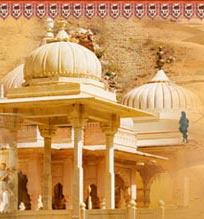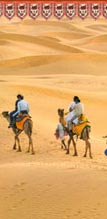 |
The Jambeshwar fair at Bikaner in Rajasthan is held twice a year. The Jambeshwar fair is held in memory of Jambheswarji.
|
Jambheswar Fair
The Jambheswar Fair is held in the Mukam village, Bikaner District, twice a year on Phalgun Budi Amavasya and Ashvin Budi Amavasya. It is held in memory of the founder of the Bishnoi sect, Jambheswarji. His teachings are condensed into 120 sayings which propagate the cardinal virtues of self-control, truth and non-violence. He taught 29 articles of religion and hence the term Bishnoi from Bees (twenty) and Nau (nine). The Bishnois consider him to be an incarnation of Vishnu. Near the Nokha Town, there are two temples of Jambheswarji, one in the village Mukam (mukam literally means abode) and the other on the sand dune of Samarthal.
The temple at Mukam has the samadhi of Jambheswarji and a life-size portrait adorns the central hall. On the ground floor, there are five rooms, one of which is used to store grain offered by the visitors and the rest serve as a guest house. The grain which is offered at the temple is used to feed pigeons, peacocks and birds throughout the year beside the temple, built specifically for this purpose.
A large fair is held in February-March on Phagun Budi Amavasya every year. It is attended by people from Punjab, Delhi, Rajasthan and Uttar Pradesh, apart from the local visitors. The second fair which is a smaller, localised affair, is attended by people coming in from neighbouring villages on camels, bullock carts and even on foot. The number of shops is lesser and comprises mostly of sellers from Nokha, Himmatsar and Bikaner. The visitors go to the temple at Mukam and the sand dune at Samarthal (where Jambhaji used to preach) and take part in the worship and rituals. It is customary to take some sand from the tank called Talai at Mukam and deposit it at the foot of the dune at Samarthal.
The temple at Mukam has the samadhi of Jambheswarji and a life-size portrait adorns the central hall. On the ground floor, there are five rooms, one of which is used to store grain offered by the visitors and the rest serve as a guest house. The grain which is offered at the temple is used to feed pigeons, peacocks and birds throughout the year beside the temple, built specifically for this purpose.
A large fair is held in February-March on Phagun Budi Amavasya every year. It is attended by people from Punjab, Delhi, Rajasthan and Uttar Pradesh, apart from the local visitors. The second fair which is a smaller, localised affair, is attended by people coming in from neighbouring villages on camels, bullock carts and even on foot. The number of shops is lesser and comprises mostly of sellers from Nokha, Himmatsar and Bikaner. The visitors go to the temple at Mukam and the sand dune at Samarthal (where Jambhaji used to preach) and take part in the worship and rituals. It is customary to take some sand from the tank called Talai at Mukam and deposit it at the foot of the dune at Samarthal.






